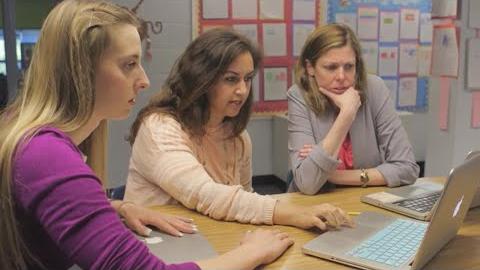Comprehension Checks

Comprehension checks are a quick way to monitor students' understanding in real time. This strategy is part of Colorin Colorado's ELL Strategy Library and can be used to support academic language development for all students.
Strategy Overview
How This Strategy Supports Students' Language Development
It's helpful to keep track of how well students understand new content along the way, rather than waiting to get that feedback through more formal assignments or assessments further down the road. Comprehension checks are an informal, timely way to help educators identify areas that need further explanation, including instructions, routines, or expectations for the classroom.
It's also important to keep in mind that English language learners (ELLs) may not wish to draw attention to themselves. Students may hesitate to indicate that they don't understand something or they may stay quiet when the teacher asks the class questions. You can use a variety of checks throughout a lesson, including some open-ended questions, to track students' understanding. Comprehension checks can also be a helpful strategy for teachers who aren't sure how to support ELLs or how well their students are understanding the content.
In addition, assure students that it's ok to let you know if they don't understand something and that you are there to help!
Different Kinds of Strategy Checks
Different kinds of comprehension checks include the following:
- Thumbs up / thumbs down: Students show a "thumbs up" or "thumbs down" when answering a "yes/no" question or when indicating whether they understand something.
- How many fingers?: Students choose how many fingers to hold up based on their level of understanding (0 is "no understanding" and 5 is "strong understanding"). Demonstrate what each number means when introducing this strategy, as Susan Lafond does in the video below.
Gestures: Students demonstrate the meaning of a new word or concept with gestures or actions.
Drawings: Students draw a quick sketch of what they understood about a chunk of information or text.
- Emojis or other visuals: Students use an emoji or other visual, such as a traffic light, to show their level of understanding or indicate when they have a question.
- Peer work: Students discuss a question in a group (either in their home language or English) and share a summary with the class or teacher. Students can also answer open-ended questions like the ones below in pairs or in a small group.
- Sentence starters: Students complete a sentence with either a general prompt or a specific prompt related to content. Sentence starters can also be incorporated into exit and entrance tickets. In addition, specific conjunctions (and, because, but, so) can be used to check students' understanding of key points and cause/effect. (See examples below.)
- Exit / entrance tickets: Students respond to a prompt either by speaking or writing. They can share their answer on the way coming in the door ("entrance ticket") or going out the door ("exit ticket"). The prompt might be an answer to a specific question or an open-ended question. Open-ended questions in particular can be a great way to collect information about what is or isn't working for students; students often have a lot of valuable insights when asked!
| Exit/Entrance Ticket Prompt | Sentence Starter |
|---|---|
| What is one new thing you learned during this lesson? |
|
| What is a question you have about today's lesson? |
|
| What is something you didn't understand today? |
|
What is something you need to practice more from today's lesson? |
|
| What is something that helped you understand today's lesson? |
|
| What was your favorite part of the lesson? |
|
Step-by-Step Instructions
- Think about what you might need to check during a lesson, such as instructions, a definition, or a new concept. In addition, consider whether there are some regular check-ins that would help support students in a specific area.
- Think about the best way to check students' understanding. Is it a quick temperature check in the middle of the lesson, or a review after the lesson? Do you need more information about what is or isn't working in the class? What will work best logistically? Is there time to do an exit ticket at the end of class, or is an entrance ticket in the morning a better fit?
- Determine if you need to do any prep or get supplies, such as sticky notes for tickets, visuals, or posting a question on the board before students come in each day.
- Teach students how to use the comprehension check you want to use, being sure to explain each level of understanding clearly and with demonstrations. Give the students some examples and ask them to practice with some low-key questions at first.
- After using a comprehension check, evaluate how well it worked, if modifications were needed, and if it gave you useful information. If not, think about what would make it more effective next time.
Differentiation
- Provide differntiated sentence frames for entrance/exit tickets.
- Start with checks that have fewer options, such as "Thumbs up / thumbs down."
Lessons Learned
- Teach these checks early in the year and use them regularly so that students get comfortable using them in different kinds of situations.
- Ensure students clearly understand how to use the checks. Remind them of how the checks work as needed.
- Kristina Robertson encourages teachers to give a new strategy several tries in different settings to see what works best. (In other words, if it doesn't work well the first time, don't give up!) If it doesn't work after you've made some modifications and tried it at different points in the lesson, you may wish to try something else. However, it still might be worth trying it later in the year.
Co-Teaching Considerations
Content or Grade-Level Teacher
- Choose the content, instructions, or other information you want to check.
- Choose when you'd like to use the comprehension check.
English Language Development Teacher
- Identify the language demands of the comprehension check your co-teacher has identified.
- Suggest some ideas for making the check as comprehensible as possible, such as scaffolds or sentence frames.
- Look for areas where ELLs might need extra explanation.
Examples
1. Ms. Kirch uses "Thumbs up / thumbs down" to check her students' understanding of whether the "drawing a conclusion" means the same as "drawing a picture" in the video below.
2. Ms. Jimenez posts a question on the board every morning for students to answer as soon as they come in and goes over the answers quickly before teaching to see if there is an area that needs additional review.
3. Ms. Saleh asks students to draw pictures of Social Studies terms, such as "bald eagle," "flag," and "the Liberty Bell." (pictured left)
4. Mr. Huynh wants to check his students' understanding about the Industrial Revolution. He asks them to complete the following prompts that use different conjunctions:
• The Industrial Revolution changed the way people worked because ...
• The Industrial Revolution changed the way people worked, and ...
• The Industrial Revolution changed the way people worked, but ...
• The Industrial Revolution changed the way people worked, so ...
He writes, "After teaching a concept, teacher can use any number of these sentence expansion structures to help students process the content. The beginning of the sentence structure is all the same, but the ending makes all the difference. Students have to actively thinking about the differences these conjunctions communicate related to the content." (Hochman & Wexler, 2017)
Resources
- 28 Ways to Quickly Check for Understanding (Edutopia)
- Using Exit Tickets Effectively (Edutopia)
References
Hochman, J. and Wexler, N. (2017). The Writing Revolution: A Guide to Advancing Thinking Through Writing in All Subjects and Grades. Jossey-Bass.






